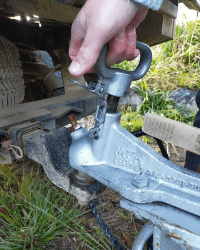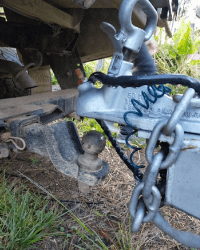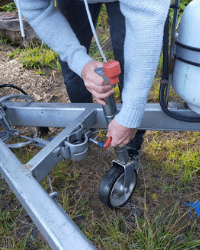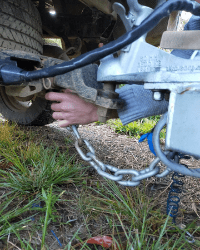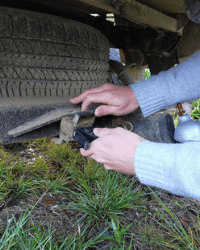Caravan Set Up Guide: CSTORM
Hiring a caravan for the first time? See our set up tips and guides for the ultimate caravan set up. Get all the information you need for the perfect camping trip with expert advice from CSTORM.
Share
So you’ve arrived! Now for the set up… If you have hired a caravan, you would have received a rundown on how to set up and pack down the van. It can all be a little overwhelming if you have never had experience with caravans before. Having confidence in towing and setting up your caravan will avoid unnecessary and preventable damage. Replacement parts for caravans can be as rare as hen’s teeth are NOT cheap!
In this post, we will cover towing info and some common set up tips and instructions to help give you a better understanding on how things work.
Also check out our other blogs with detailed setup and pack down guides for each of our CSTORM Caravans.
Why is Setting Up a Caravan Important?
Setting up your caravan correctly and more importantly, safely, will ensure your holiday isn’t interrupted with nasty little surprises arising from poor set up. A broken or incorrectly set up awning can really put a ‘damper’ on things….especially if it starts raining!
Our Caravan Set Up Tips
The info tips below are general to most caravans. For more detailed caravan specific set up and pack down guides, see our individual ‘Setup and Pack Down’ instruction blogs for each of our caravans.
Hitching up
1. Wind the jockey wheel up so that the coupling rests just above the height of the tow ball.
2. Reverse your tow vehicle so that the tow ball is positioned beneath the coupling. Depending on the weight of your caravan, you may be able to drag the draw bar into position rather than reversing into position. Not recommended if you’re positioned on uneven/sloping ground.
3. Lower the jockey wheel so that the coupling sits on the tow ball and the tow bar supports the full weight of your caravan. Lock the coupling onto the tow ball in place by engaging the coupling latch. Insert safety pin through the coupling latch.
4. Try to lift the draw bar to ensure the coupling is secure
5. Raise and spin the jockey wheel into its travelling position or, on some caravans you will remove the jockey wheel completely.
6. Cross the safety chains beneath the tow bar/hitch and secure with D-shackles.
7. Connect the caravan’s electrical lead to the socket on the towing vehicle. Also connect the Anderson plug if the towing vehicle and caravan have one.
8. Gather up any slack from the electrical lead to avoid it dragging on the road. Some electrical tape can help with this. Check and shorten the safety chains if they are too close to the road by moving the D-shackle along the chain to reduce slack . Larger caravans are fitted with a breakaway. Connect the breakaway cord to the tow bar.
9. Disengage the caravan’s handbrake.
10. Where used, remove the chocks from the tyres and stow away.
11. Check the caravan’s rear lights are working correctly.
12. If using an Electronic Brake Controller, ensure it has been set up correctly. You may need to do a few test brakes before taking off to make sure the correct braking speed has been set up.
Take it easy while you tow
Towing a caravan is the ultimate in freedom and adventure filled holidays. It’s also a HUGE responsibility. It requires unwavering concentration and attention to what is happening around you at all times. The slightest driver error can result in major problems and can be extremely dangerous to you, the occupants in your vehicle and other motorists.
- Store items in your caravan evenly and securely.
- Double check the condition of your car and caravan including (but not limited to) couplings, chains, brakes, and tyres before and during your trip.
- Accelerate, brake and steer smoothly and gently to avoid swaying. Once the caravan starts swaying, it can be quite nerve-racking. Some people panic and try to over correct causing more swaying. Smooth gentle movements always!
- Allow for double the distance and time to slow down when braking. Leave a bigger space between you and the car in front and always allow more space and time for slowing down and stopping. Ease into the breaks and NEVER attempt a hard stop..
- Slow down when larger vehicles pass in either direction to avoid swaying caused by wind buffering. Always be aware of the cars/trucks around you. Your blind spot increases when towing a caravan.
- Allow for extra time when overtaking – and for the extra size of the caravan! You’re a big rig now – you are going to need more time and room!
- Don’t be pressured by the flow of traffic to go faster than you are comfortable.
- Make sure there is no oncoming traffic when overtaking. Never overtake on a bend or crest. Even better, take your time and do not overtake unless absolutely necessary and safe.
Position the caravan on the site
We have all done it, relaxing in our lovely set up annex watching the newbies do the 20 point turn polka trying to reverse into a site. (knowing full well that it was us doing exactly that only two hours ago!). Before positioning your caravan onto the site, take into consideration where the services are (power and water) in relation to where your van will be. Will the hose and power cord reach? What side of the site will you be on? (where is the entry door located?). There is nothing worse than having to hitch back onto the car and move (again!). Have someone guide you back onto the site….Sounds simple rite? Hot tip…have them stand on the drivers side so they are visible and have your window down so you can hear them. Agree on signals and verbal cues before backing in the caravan to avoid any ‘frustrating’ miscommunication and not so nice hand signals.
If you are really nervous and have absolutely no towing experience, consider taking a caravanning 101 course. Check out; https://www.withoutahitch.com.au/caravan/best-caravan-driving-courses-australia/
Or at the very least, have some practice maneuvering the van before you head off.
Level and uncouple the caravan
- Have your levelers out and ready to go should you need to level out the caravan once in position. Before ANYTHING else, pull on the caravan handbrake! Engage or attach the jockey wheel. Sometimes it helps to put a piece of wood under the wheel to stop it from sinking into soft ground.
- Take out the safety pin through the coupling latch. Disengage the coupling latch. Disconnect the electrical lead and safety chains.
- Wind up the jockey wheel so the coupling sits clear of the tow ball. Drive forward slightly to be clear of the drawbar.
- Wind jockey wheel up or down to level out the Caravan.
Lower the corner steadies
Before entering the caravan, lower each corner leg stay, located at each corner of the caravan. These legs are not made to take the weight of the caravan so only extend them until you just feel some pressure.
Switch on the facilities
Attach power lead, water hose and sullage hose. If the sullage hose does not reach or there is no sullage point, a bucket under the sink outlet will work well. Just remember to empty it regularly but leave some water in the bottom so it doesn’t blow away.
Open the awning
Most awnings operate very similarly but have slight differences in operation. Never force the arms or legs into position. If it’s not moving smoothly, then you’ve missed a step or latch or clip.
- Check the lock and release latch on the awning is in the correct position.
- Make sure you fully roll out the awning before attempting to extend the arms.
- Use ropes and pegs to secure awning
- Awnings aren’t great in high wind situations. If the wind picks up you may need to roll the awning up. It’s a good idea to check the weather forecast before heading out for the day. If you are unsure, lowering the awning height also helps to resist damage when it’s windy.
Learn more about setting up your caravan
We hope this has given you some great tips and information around setting up your caravan and you can be on your way knowing a little more about what to expect and how to safely set up your home away from home!
For more detailed ‘caravan specific’ set up and pack down guides, see our individual ‘Set up and Pack Down’ instruction blogs for each of our CSTORM caravans available for hire.

